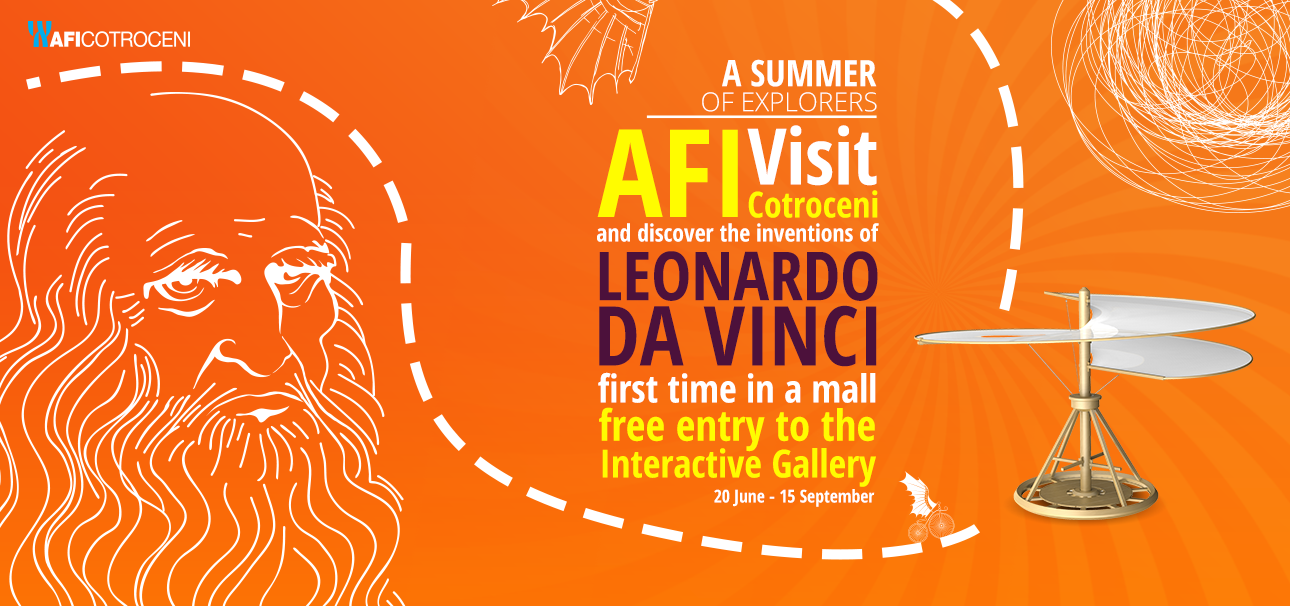Come between 20 June and 15 September at AFI Cotroceni and explore the interactive exhibition “Leonardo Da Vinci’s Inventions”!
Between June 20 and September 15, AFI Cotroceni awaits you in the cinema area to explore the inventions of Leonardo da Vinci.
The 44 machines were also present in 76 other cities across the continent, each time attracting tens of thousands of visitors.
You can admire the war machines, two flight machines, hydraulic machines but also many concepts and principles of mechanics.
The entry is free.
Daily guided tours program: 10.30; 11.30; 12.30; 13.30; 14.30; 15.30; 16.30; 17.30; 18.30; 19.30 20.30; 21.30.
ABOUT
The exhibition brings together 44 reconstructions of the Renaissance genius inventions made by the Leonardo da Vinci Museum specialists in cooperation with the academic environment under the strict supervision of Professor Carlo Pedretti, acknowledged for the perseverance and complexity of the approaches that enriched Leonardo da Vinci’s mechanics.
Some of the exhibited models are interactive and allow the visitor a pleasant experience because they were made using the materials of the era of the one who imagined them: wood, cotton, brass, iron, and cable. Explanations of the exhibits are presented alongside a picture of the page on which these inventions were drawn and which are now contained in the various notebooks that belonged to da Vinci, of which the most recently discovered: Codex Madrid.
In 2001, the Italian Government recognized the high quality and qualification of the exhibits made by the Leonardo da Vinci Museum and awarded it the special prize “Italia che Lavora”.
Twenty years after the first exhibition, the total number has surpassed 100 exhibitions of Leonardo da Vinci Machines worldwide, being approved by scientists and under the patronage of the municipal councils or the ministries of culture in the host countries.
The shows were also featured in television shows, documentary films, or even in Hollywood films: Da Vinci – Discovery HD Channel Canada, Da Vinci – Japanese documentary (NHK channel), “The Bridge to Terabithia “, Walt Disney Film,” Bicycle building, a life story “- Documentary Beca NZ, Da Vinci -” Robot Anatomy “, ABC 7.30 Report.
Leonardo da Vinci has been passionate about scientific studies in anatomy, biology, mathematics, and physics. His manuscripts, known as codecs, present ingenious solutions to the practical problems of time and were able to imagine future possibilities such as flight and automation devices. At the death of Leonardo, all his writings and sketches were inherited by his trusted assistant, the scholar Francesco Melzi. He kept and cataloged them carefully, but after his death, most of the works were dispersed. Approximately one-quarter of Leonardo’s manuscripts survived, most of which were later grouped by scholars in Codex and Manuscripts of different chronologies and dimensions.
The original concept of creating an “interactive machine” exhibition based on Leonardo’s notebooks was developed by the Leonardo da Vinci Museum in the early 1990s with the approval of eminent researchers and historians.
Thus appeared the exhibition that “brings to life” the genius and inventions of Leonardo. Since then, the exhibition has traveled around the world in cities and centers such as Siena, Fiesole, Venezia (permanent museum), Aquila, Rome, Naples, Palermo, Milan, Turin, Taormina, Ortigia, Catania, Cagliari, Trento, Bergamo, Assisi, Alessandria, Sassuolo, Bologna, Pavia, Livorno, Varsavia, Bucharest, Paris, Rombas, Strasbourg, Madrid, Berlin, Vienna, Hartberg, Copenhagen, Hull, Bremen, Monaco, Praga, Bruxelles, Basilea, Lugano, Helsinki, Cyprus , Beirut, Rouen, Rio de Janeiro, Belhorizon, San Paolo, Brasilia, Toronto, Montreal, Chicago, Seattle, Sacramento, Houston, San Diego, San Francisco, Detroit, Los Angeles, Palmspring, Las Vegas, Hong Kong, Dubai, Melbourne, Palmerston, Sydney, Perth, Adelaide, Hollywood, Shanghai, Guangdong, Dailan, Seoul, Busan, Macao, Taipei, Jeju, Brisbane, Christchurch, Wellington, Auckland, with over 15 million visitors.

